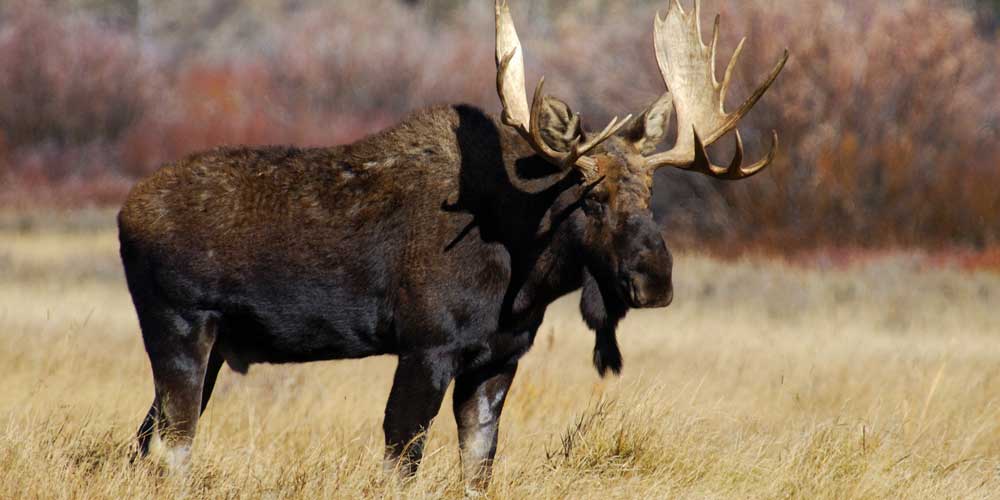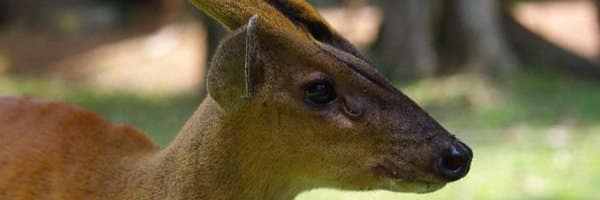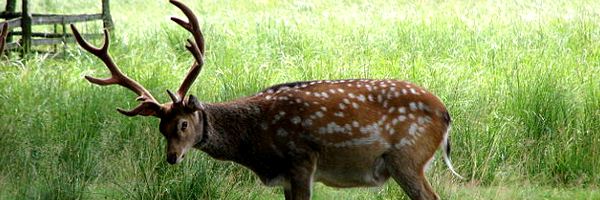Moose – Alces alces
Of all the different species of deer out there, the Moose is the largest of them. They can reach a weight of about 1,500 pounds for the males. Even the females can be at least 1,100 pounds. There is lots of variation in there size but this is a very good overall range. When it comes to their height you can expect to see an animal that stands about 8 feet tall.
The antlers of these animals are truly amazing. Did you know that they can span from four to six feet in distance? These antlers are very heavy too. They have a very thick coat that helps to keep them warm in colder regions. Those that live in areas where it is warm in the summer will have a thinner coat then. It will change to prepare them for the seasons.
The coloring is a brown that resembles the shade of chocolate. They have very bulky bodies with a drooping nose. They also have an area of loose skin underneath the chin. They also have very wide nostrils.
Moose Anatomy
The anatomy of the Moose is very similar to that of a horse. They have exceptional hearing, and that comes with their large ears. These ears can pivot to be towards the sounds that they hear. They can move only one ear at a time or both of them so they have lots of control over the range of what they pick up.
They have eyes that are large and brown. These eyes can also be pivoting either as a pair or alone. This allows the Moose to have a very wide range of vision. The only place they can’t see is the area directly behind them!
The nose of the Moose is very large and also helps them. They are very good swimmers and can conserve energy by moving like that. Their nose has a valve in it that allows them to go underwater without taking in any water as they do so.
With the weight of a Moose, you may wonder why they don’t sink into the mud as they move around. They have a design of their toes that prevents that from happening. The toes spread slightly to help them shift their weight. Surprisingly, the heavy Moose is still able to move at a speed of up to 35 miles per hour when necessary.
Moose Evolution
Fossilized remains from Asia have given us some basic information about the Moose. We know that the animals today are ancestors of those from that period of time. These findings date back about 2 million years but it is strongly believed that they lived longer than that. We just haven’t found any fossils that are older yet to prove it.
It is believed that they traveled during the Ice Age from Asia into Alaska. They may have lived in areas that were warmer long ago. Their movements for unknown reasons could have triggered the need for them to develop thicker fur. They are smaller now than the fossil remains which is also very interesting. It is likely that they moved and that they evolved in order to find food.
Moose Behavior
Moose are solitary animals that don’t live in herds. This is very different than the lifestyle of the females for other species. However, these animals are very aggressive when it comes to protecting their territory. They have strong odors that their emit to mark their territory. The females do have a home range that overlaps with many other females. They tend to ignore each other and go about their distance.
The situation is different for males as they don’t want another in their territory. This proves to make it very hard for a young male that is newly out on its own to be out there looking for territory where it can be established.
Moose Habitat and Distribution
There are quite a few different locations out there where you can find the Moose living. They include Europe, Canada, North America, and Russia. They do like areas that can become warm in the summer but very cold in the winter. That isn’t a necessity though as many Moose live well in the Sub Artic regions where it is cold all year long.
Moose Feeding Habits
The Moose spends most of the waking hours looking for food. They can consume up to 9,800 calories in a single day. The females consume less than that but still a terrific volume of it. They eat many different things found in their environment. This includes grass, birch, willow, twigs, and sage.
The habitat where a Moose lives will determine what food resources it happens to have access to. The changing seasons also influence what they will eat at any given point in time. For example there are fruits that are found seasonally and they really do enjoy eating them when they can.
Moose Reproduction
The rut occurs from September through October for the Moose. The males that are able to be tougher than the rest are the only ones that get to mate. They will engage in long battles with other males to be able to show that they are the ones with the dominance. Finding females to mate with can be a long journey due to the fact that they don’t stay in a herd together.
The most common sound that the Moose offers is known as bugling. The males will use this to find the females out there. Once she has responded the calls will go back and forth so that they can find each other. The male will mate and then quickly move on to locate other females that he can also mate with.
About 8 months after mating the female will give birth to one offspring. However, research shows that when food is plentiful there can be a high instance of twins being born that particular year. The females are excellent at caring for the young and will do so for a couple of years. Then the young have to be ready to take care of themselves out there. The average life span of a Moose in the wild is 22 years.
Moose Predators
Small Moose out there can become a source of food for wolves and for bears. They won’t often mess with full sized Moose due to the fact that they are very strong. A kick from their hooves can cause severe damage or even crush a skull. When these types of animals are desperate for food though they may try to take down an adult that is sick.
Humans also hunt for Moose due to the size of them. They offer lots of meat and their antlers make a wonderful trophy to keep. Hunting for them can be very challenging and time consuming. Learning how to track them is part of the success that a person will have. Many hunters look for them during the rut when the males are on the move.
They will rattle antlers to draw them out as that sound indicates that two other males are having a battle for mating rights. As the Moose emerges to find them and to battle for his right, he may be taken down by a hunter.







